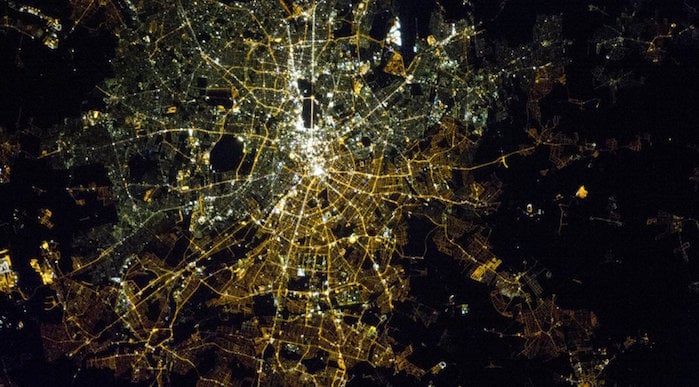
AMA Report Affirms Human Health Impacts from LEDs

A groundbreaking report recently released by the American Medical Association (AMA) Council on Science and Public Health affirms known and suspected impacts to human health and the environment caused by light emitting diodes (LEDs) that emit excessive amounts of blue light.
The AMA report, titled “Human and Environmental Effects of Light Emitting Diode Community Lighting,” unanimously approved by representatives of the Association’s entire membership, supports concerns raised by the International Dark-Sky Association for more than five years. The report presents significant implications for the ongoing, worldwide transition to LEDs as the outdoor lighting technology of choice.
“The AMA’s study not only provides additional rigorous scientific evidence to buttress IDA’s longstanding efforts to raise awareness of the potential hazards of blue-rich light, but also speaks to the bold leadership that the medical community has consistently demonstrated on this critical human health and environmental issue,” IDA Executive Director J. Scott Feierabend noted.
IDA’s 2010 white paper, “Visibility, Environmental, and Astronomical Issues Associated with Blue-Rich White Outdoor Lighting,” detailed the threats associated with exposure to blue-rich white light sources.
While the AMA report supports the use of LED lighting in order to reduce energy consumption and the use of fossil fuels, it recognizes that some LED lights are harmful. The report details findings from an increasing body of scientific evidence that implicates exposure to blue-rich white light at night to increased risks for cancer, diabetes and cardiovascular disease.
Not only is blue-rich white LED street lighting five times more disruptive to our sleep cycle than conventional street lighting, according to the report, but recent large surveys have documented that brighter residential nighttime lighting is associated with reduced sleep, impaired daytime functioning and a greater incidence of obesity.
As a result of a potential risk to public health from excess blue light exposure, the AMA report encourages attention to optimal design and engineering features when converting from existing lighting technologies to LED. These include requiring properly shielded outdoor lighting, considering adaptive controls that can dim or extinguish light at night, and limiting the correlated color temperature (CCT) of outdoor lighting to 3000 Kelvin (K) or lower. Color temperature is a measure of the spectral content of light, and higher CCT values indicate a greater amount of blue light that a fixture emits.
In 2014, IDA revised its Fixture Seal of Approval (FSA) guidelines to limit blue light emission by outdoor lighting by lowering the acceptable color temperature for approved lighting products to 3000K or below. The IDA FSA program provides third-party certification for lighting that minimize glare and light pollution, and reduce light trespass.
The AMA findings also underscore the fact that detrimental effects of blue-rich LED lighting are not limited to humans. “Other species are just as vulnerable to disruption of their circadian rhythms as are humans, and often more so,” explained Travis Longcore, Ph.D., Assistant Professor of Architecture, Spatial Sciences, and Biological Sciences at the University of Southern California. “Those impacts and others can be reduced by limiting blue-light emissions. Policy makers, government officials, and the American public now have the science and the imprimatur of the AMA to insist that LED installations be designed to reduce impacts on wildlife and human health.”
In 2009 the AMA unanimously adopted a resolution endorsing the use of fully shielded street lighting to minimize nighttime glare, and in 2012 it released a comprehensive report expanding its position on glare and addressing the impact of light at night on human health. The 2016 report represents the first time the organization has focused specifically on LED technology.
“The AMA has a long history and strong record of developing sound, science-based policy on lighting and human health, and adoption of these guidelines builds on that tradition,” explained Dr. Mario Motta, report coauthor and former IDA board member, and past president of the Massachusetts Medical Society. “Our hope is that municipalities will use the report’s guidelines when considering the adoption of LED street lighting, making their communities safer for both humans and wildlife.”
The AMA announcement comes on the heels of the recent publication of the “World Atlas of Artificial Night Sky Brightness,” a groundbreaking study cautioning that street lighting and outdoor lighting retrofits using 4000K lamps could result in a 2.5-fold increase in lighting pollution. The finding is significant both for lighting retrofits in industrialized economies, as well as first-time lighting installations in economies beginning the transition to industrialization.
“This is a timely and important policy statement by the AMA,” said Richard Stevens, Ph.D., a cancer epidemiologist at the University of Connecticut School of Medicine and coauthor of the report. “As with most new technology, everyone is enamored at first because it’s so great and does so much for us, but the downsides eventually become apparent. Electric light has great attributes, but we now realize, when poorly used and abused, there are also many problems.”
You Can Make a Difference
The publication of the AMA report and the “World Atlas” provide a great opportunity to contact your public officials about combating light pollution. Learn how.

















